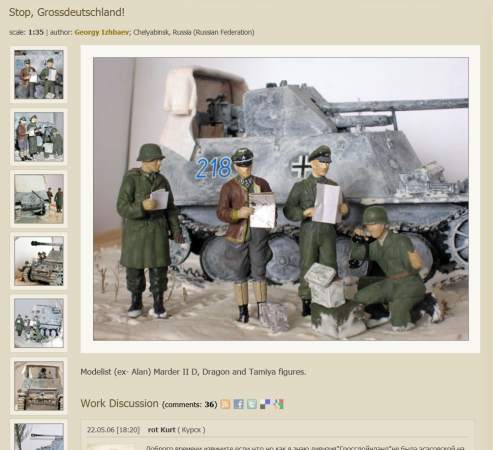The next step was to paint the vehicle commander. I painted him using the technique I used for most of my army-type painting for troop-type figures. I used Ceramcoat Flesh, thinned lightly with water, for the face and hands. For his uniform blouse, I again went with the color Battlefront recommends: Vallejo 880 Khaki Grey (again, thinned with about 1-part-in-3 water). For the tanker's helmet, I mixed a little flat brown into my Khaki Grey to darken it a bit.
Once the commander was done, it was time to do a little detail work on the vehicle. I decided to use an air-recognition device, as this was a very common practice for recon vehicles. The Russians in the early- and mid-war periods tended to use geometric shapes painted on the turret hatches as air recognition devices, so I painted red triangles on one of the hatches.
The next step was to paint tactical markings and patriotic slogans on the vehicle.
A lot of people (my self included) can find hand-painting these features very intimidating at first, and you can use decals instead, but I take a perverse pride in hand-painting all my markings and insignia on my tanks.
Russian tactical markings tend to be small geometric shapes in either white, yellow, or red, with a bewildering array of numbers arranged in and around the shape. These tactical markings were developed on a theatre level, and changed often (as did the air-recognition symbols). The good thing about that is you can do almost anything here and be reasonably historically accurate.
My primary reference for Russian tactical markings and patriotic slogans is a book titled The Eastern Front, Armour Camouflage and Markings 1941 to 1945 by Steven J. Zaloga and James Grandsen. There are almost an infinite number of different patriotic slogans you can put on a Russian vehicle. I picked one out that was short, because the hull of the BA-6 is small. The slogan on these armored cars is the name of a Russian Civil War hero.
Painting these markings in 15mm takes a 10/00 brush and a bit of practice, but once you get the hang of it, it's pretty easy. (If you don't get the hang of it, there are always commercial decals.)

The next-to-last step in the process was to give the vehicle commander a very light wash with Games Workshop brown ink, thinned with water.
Then the last step in the weathering process was to take some brown artist chalk, and grind it into a paste on some fine sandpaper. (I saw on TMP that there is a company now that sells the chalks already ground to a powder for you.) Take a slop brush and dip it into the powder, then brush the powder on the bottom half of the vehicle.
The trick when using these powders is being careful when you seal the model with a matte or gloss coat to protect the figure. Give the model a very light spray, and let it dry before you give it your regular clearcoat finish. Over-spraying the figure with chalk weathering will cause the chalk to liquify and run, ruining the effect you were going for.










